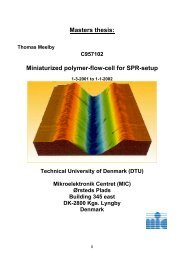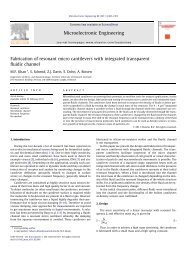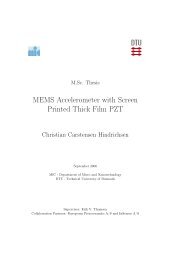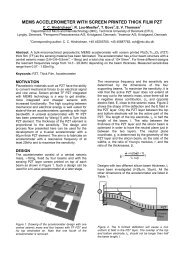Prototyping of microfluidic systems with integrated ... - DTU Nanotech
Prototyping of microfluidic systems with integrated ... - DTU Nanotech
Prototyping of microfluidic systems with integrated ... - DTU Nanotech
You also want an ePaper? Increase the reach of your titles
YUMPU automatically turns print PDFs into web optimized ePapers that Google loves.
2.3 Waveguide optics 15<br />
<strong>of</strong> one <strong>of</strong> the two. An other way <strong>of</strong> minimising the problem is by<br />
designing waveguide <strong>with</strong> tapered ends, so that the light is guided into<br />
the structure.<br />
2.3.3 Waveguide bends<br />
Light can propagate in a waveguide for long distances <strong>with</strong> very limited<br />
loss – for optical fibres the losses are typically measured in dB/km. The<br />
loss will, however, increase if the waveguide changes dimension, e.g. in<br />
the form <strong>of</strong> a bend. Since the incident angle will no longer be the same<br />
on both sides <strong>of</strong> the waveguide, the ray could eventually hit the sidewall<br />
at an angle smaller than the critical angle, meaning that it would be<br />
partially refracted out <strong>of</strong> the waveguide. The loss depends on the ratio<br />
between the radius <strong>of</strong> the bend R and the half-width ρ <strong>of</strong> the waveguide.<br />
In practice, the optical losses from a bend are negligible when R/ρ > 10 3 .<br />
For details, the reader is referred to e.g. [12].<br />
n 1<br />
n 2<br />
R<br />
Figure 2.4: Planar waveguide bend. The incident angle <strong>of</strong> the rays on the sidewalls<br />
change because <strong>of</strong> the bend geometry, meaning that the rays at some point could<br />
have an incident angle below the critical angle. This will lead to refraction out <strong>of</strong> the<br />
waveguide. In a planar waveguide bend, the ratio between the radius R <strong>of</strong> the bend<br />
and the half-width <strong>of</strong> the waveguide ρ is the main determinant <strong>of</strong> the optical loss in<br />
the bend. In practice, for R/ρ > 10 3 the losses are negligible. Adapted from [13].<br />
2.3.4 Tapered waveguides<br />
Waveguides can be tapered at the entry to facilitate coupling <strong>of</strong> the light<br />
into the structure. This can be an advantage in two cases, namely if<br />
ρ










